06 - Medical Database
Created by Commander Morgan Tarin on 01 Nov 2023 @ 2:18pm
Table of Contents:
- 6.1 Akkadian
- 6.2 Axans
- 6.3 Bolian
- 6.4 Cereijan
- 6.5 Nekomi
- 6.6 Orion
- 6.7 Tholian
- 6.8 Tribble
- 6.9 Trill
- 6.10 Vaeron
6.1 Akkadian

MEMBERS
Breeding males being approximately 1.5 to 1.8 meters tall but weighing less then the average human adult male with ranges approximately 63 to 70 kg.
Females, which are all fertile, range in height equivalent to breeding males but more gracile in structure with weights 40 to 50 kg.
Non-breeding sterile males are also present with heights 1.9 to 2.2 meters and weights of 95 to 115 kg average. Primarily work in heavy labor. Hollowness of the bones is greatly reduced and larger; air sacs reduced as well but lungs more prominent.
RESPIRATORY SYSTEM
Unidirectional air flow similar to Terran birds (air flows only once into the lungs)
Lungs with air sacs
One (1) Interclavicular air sac
Two (2) Cervical air sacs
Two (2) Anterior Thoracic air sacs
Two (2) Posterior Thoracic air sacs
Two (2) Abdominal air sacs
RESPIRATORY CYCLE
Anterior air sacs - (1) Interclavicular, (2) Cervicals, and (2) Anterior Thoracics
Posterior air sacs - (2) Posterior Thoracics and (2) Abdominals
Inhalation - air from outside the body into the Posterior air sacs
Exhalation - air from Posterior air sacs to lungs
Inhalation - air from the lungs to the Anterior air sacs
Exhalation - air from the Anterior air sacs out of the body
NERVOUS AND EXCRETORY SYSTEM
Organized similar to Humans.
There are some modifications to the execratory system due to diet.
DIGESTIVE SYSTEM
Flight and most daily activities have a need for sugar. Repair and especially the development of eggs require a source of protein.
The digestive system is organized in a way that Akkadians can store food of both types (sugar and blood) which can be utilized to give access to both as needed.
When a sugar solution is imbibed it goes not to the stomach but is redirected to a special pouch called a crop. The crop can release sugar into the stomach as it is required. At the same time, the stomach never becomes full of a sugar solution which would prevent the utilization of blood when it is available.
Blood is directed straight into the stomach. Blood imbibed into the stomach is surrounded by a peritrophic membrane secreted by the stomach that surrounds the blood bolus to prevent pathogenic organisms in the blood bolus from crossing into the Akkadian blood stream while digestion occurs.
The blood bolus is then passed to a secondary stomach which is connected directly to the kidneys.
As the secondary stomach contracts the fluid from the blood bolus is thus sent directly to kidneys in order for it to be eliminated. The bolus is then passed into the midgut for digestion, thus freeing the stomach to continue to be able to absorb sugar.
VISUAL SYSTEM
Two eyes:
Transitional compound eyes. Omatidia or facets become less pronounced toward the middle with the center being a larger lens for ability to make for increased visual imaging.
This allows detailed imaging which normal facets do not but retains the ability to detect movement much finer then the normal single lens eye.
Parts of the eye in females are specialized an acute fovea - an area specialized for detailed imaging (this is used for visual nagivation - see reproduction).
Capable of perceiving light in 280 to 700 nm range. Thus, they are capable of seeing into the ultra-violet range but lack sensitivity in the red range compared to humans. The metallic streaks in the hair will show patterns if viewed in UV light.
CIRCULATORY SYSTEM
Hemoglobin - iron based
Hearts: 3
The first consist of twin two-chambered hearts which supply blood to the respiratory system and wing musculature.
The third is a four-chambered heart to supply blood to the rest of the body and interconnected with the two chambered system.
SKELETAL SYSTEM
Akkadian skeleton is highly adapted for flight. It is very lightweight but strong enough to withstand the stressed of taking off, flying and landing.
Parts of the skeleton where the wings attach are fused into a single ossification.
Many of the bones are pneumatized (hollow) with criss-crossing struts and trusses for structural strength.
Respiratory air sacs form air pockets within the semi-hollow bones.
WINGS
Akkadians are remarkable in that they represent one of the few known humanoids possessing natural flight.
The wings are organized into two pairs the forewings and the hindwings.
Each of the wings is strengthened by a number of longitudinal veins having cross-connections that form cells in the membrane.
The wing muscles are attached directly to the wing base such that a small downward movement lifts the wing, another set pulls the wing back down.
Since each wing is independently connected, this results in the amazing ability of being able to hover, fly backwards and dart.
Due to independent nature of the wings, the hind wings can beat a fraction of a second different and take advantage of air flowing off the forewings resulting in a highly efficient form of flight.
At rest, the wings are held flat and can be folded along specific fold lines. The pressure in the veins can be relaxed as well to allow the wings to 'flex' further.
REPRODUCTIVE SYSTEM AND REPRODUCTION
Internal insemination between breeding males and females.
Males have internal testes (due to lower body temperature) but external phallus.
Female's posses a vagina that branches into two oviducts leading to the ovaries (two).
Both fertile males and females remain fertile until their last year of life.
The females if fertilized then produce eggs which they then lay in the shallow waters of the many coral reefs. In order to do so, they develop a set of membranous wings similar to dragonfly or technically damselfly wings since they lay parallel to the body. Fertile males may sometimes develop wings but it is quite uncommon for them to do so.
Henimetabolic development in which there is an egg, a nymph stage and then an adult stage.
The eggs develop and emerge as a nymph stage in a small humanoid form which the Akkadians call Khar'atah but lacking legs and equipped with a tail for life in the oceans.
The nymph phases of Akkadian development spends about a year at sea and then go back to where they were laid and gathered again by the females.
Nymphs then develop rapidly into small adult forms.
The late stage nymphs are nourished as in mammals.
Hormonal variations in the milk determine if the developing youngling becomes non-fertile male, breeding male or female.
6.2 Axans
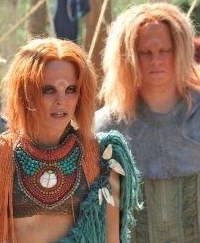
MEMBERS
Each species branch of the Axans have their own characteristics based on sex. It is worth noting that they interbreed.
Axan’ka male are between six and eight feet tall, weighing around 200-300lbs. They are naturally muscled.
Axan’ka females are around 5’5” to 6’5” and weigh around 155-190lbs. They are less muscled than the males but have powerful leg muscles, most likely due to them being natural sprinters.
Axan’e males and females are around 6 feet to 8 feet tall, weighing 300 to 400lbs. The males have longer limbs than the females and the females tend to have longer spines.
Axan’hen males are 4’5” to 5’5”, weighing around 120 lbs. Their webbings are colourful, usually a few shades darker than their hair.
Axan’hen females stand between 4 feet and 5 feet, weighing between 80-100 lbs. Their webbings are transparent, thought to have been to be in order to appear invisible in the skies.
ORGANS AND SKELETON
The Axans have a skeleton similar to that of humans, but their bone density is higher and absorbs the iron in their environment, lacing with the calcium. As a result, the Axans have incredibly strong bones. Their organs are in general like those of humans, as is their placement, with exception to the increased size of the liver (twice the size of an average human’s) and the placement of the heart (underneath the diaphragm).
The Axan’ka are unique to the Axans in the sense that they could be classified as xerocole. They are able to obtain a large percentage of their water from the metabolic processes used to break down their food.
The Axan’e have increased lung capacity, able to stay underwater for hours if needed.
The Axan’hen have hollow bones, which lightens their weight. They also are unable to process carbohydrates properly, relying on high protein diets instead.
The Axans reproduction abilities are similar to those of humans, with similar sexual organs, but with some differences. The males have their testicles inside of them, descending only when aroused. It has been surmised this was due to the planet’s harsh environment. The females are like human females, except for only having one ovary. As only on average four viable eggs are produced by Earth-year, the fertility window is short for Axans females, usually lasting 10 years. Despite this, the Axans do not go through menopause until their 50s, when they start to age rapidly as they become intolerant towards the iron that has gathered in their system.
MUSCLES
Due to the heavier bones, with exception of the Axan’hen, the Axans tend to be stronger than the average Human, with males being around the same strength as an adult Klingon male. Females are not as strong, but fast, able to run 40mph in sprints.
IMMUNE DEFENSE
The Axans have a strong immune defence, making them immune to the symptoms and effects of the majority of illnesses, both native to their planet and from other planets. This however makes them ideal carriers and regular screening happens before and after interacting with other species.
DIET
The Axans, with the exception of the Axan’hen, are omnivores, but also able to process metals for nutrients. This has been thought to have been due to everything on their planet having been contaminated by it, so their bodies started to take from it.
6.3 Bolian

MEMBERS
Sexual dimorphic.
Females - average 1.58 meters and 66 kgs.
Males - average 1.73 meters and 80 kgs.
On average males and females tend to be slightly shorter and heavier than Humans.
RESPIRATORY SYSTEM
Two lungs occupying the thoracic cavity. A diaphragm is present.
For all purposes the respiratory system can be considered equivalent to Humans.
NERVOUS AND EXCRETORY SYSTEM
Nervous systems is organized similar to Humans.
Bolians have a bilateral duplex kidney system. That is, there are two kidneys on each side. Each is supplied with their own ureter.
DIGESTIVE SYSTEM
Bolians have a very interesting digestive system, one that is highly adapted to handle a wide range of foods.
The tongue has a cartilaginous lining consists of very tiny calciferous teeth that add in grinding along with the normal dentenate teeth. This allows them to consume foods other species are not normally capable of handling.
Organization of the Bolian digestive system is different than most humanoid species especially the stomach which is more akin to ruminates:
A larger cavity like the rumen which can be bypassed depending on the fibrosity of the material ingested. The rumen, far and away the largest of the forestomaches, is itself sacculated by muscular pillars into what are called the dorsal, ventral, caudodorsal and caudoventral sacs.
A smaller cavity similar to the reticulum.
Material then passes to the Omasum and then to the Abomasum.
The interior of the rumen, reticulum and omasum is covered exclusively with stratified squamous epithelium similar to what is observed in the esophagus. Each of these organs has a very distinctive mucosa structure, although within each organ, some regional variation in morphology is observed.
The Abomasum is a truly glandular organ similar to that found in monogastric species.
The pH of saliva and the acid of stomach are much lower in pH than other species. This is probably an evolutionary advantage allowing Bolians to be able to consume rancid and rotten materials. The low pH killing many pathogens. See more under circulatory system.
The rest of the intestinal system can be considered similar enough to Humans.
The sheer size of the stomachs is what results in most Bolians being rotund in general appearance.
VISUAL SYSTEM
Two eyes:
Simple non compound eyes.
Virtually identical to humans but the pigmentation is nearly always a variation of a dark blue.
CIRCULATORY SYSTEM
Haemocyanin - copper based but has a different valence than Vulcan and similar bloods.
It is extremely important not to do transfusions between the two types of copper based systems as death can occur.
Hearts - four chambered based on bilateral symmetry. For all purposes of treatment not different from Human. However, Bolian hearts are located to the right side of the chest cavity.
The pH of the blood is much more acidic than other humanoid species. This is probably an evolutionary achievement allowing Bolians to digest even rancid and rotten materials. The low pH in their fluids killing many pathogens. However, it also results in toxic results to non-Bolian partners.
SKELETAL SYSTEM
Bolian skeletal system is humanoid and little to remark on from its Human counterpart other than being much more robust than in Humans.
SKIN
Bolians are distinctive for a bifurcating and cartilaginous ridge running vertically along the center of the head and face and partway down the chest.
Skin colour ranges from a light green-blue to blue-gray to vivid blue and is occasionally accented with dark blue bands on the head.
Bolian males are bald and most females are bald as well.
Body hair is absent as well.
REPRODUCTIVE SYSTEM AND REPRODUCTION
Internal insemination between males and females.
Males have bilateral testes and external phallus.
Females posses a vagina, cervix, uterus and ovaries similar to Human.
Due to the extensive linkage of blood chemistry, most Bolian fluids run to much lower pH than other species and inter-species intimate relationships tend to be detrimental to the non-Bolian partner.
ENDOCRINE SYSTEM
The endocrine system of Bolians is organized similar to Humans.
METABOLISM
Endothermic.
Body temperatures tend to be nearly identical to Humans.
OTHER
Bolian courtship initiation consisted of a male and female Bolian pressing foreheads with eyes closed, while both participants touched the neck of their partner with both hands, placing the fingers where one would check the pulse of a species with a circulatory system similar to that of humans. Bolian marriages sometimes involved more than two members. Any additional spouse was referred to as a "co-husband" or "co-wife", respectively.
6.4 Cereijan
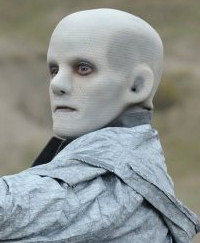
MEMBERS
Males and females have very similar height and weight and it is often difficult to see the difference. Females tend to have softer features than their make counterparts but that is not always the case. The average height for a Cereijan is 1.7 metres and average weight is 70kg.
RESPIRATORY SYSTEM
One lung occupying the thoracic cavity. A diaphragm is present.
The lung is protected not by a number of ribs, but by four bone structures that are fused. This does not allow the same expansion that humans have and their chest does not rise and fall with the breaths.
NERVOUS AND EXCRETORY SYSTEM
The nervous system of the Cereijan consists of a Central Nervous System and Peripheral Nervous System.
Unlike humans, all the Cereijan’s nerves are mixed nerves and function both as efferent and afferent nerves.
DIGESTIVE SYSTEM
The Cereijan’s digestive system shares some similarities with humans. Like humans, they have teeth which helps blending the saliva with the food for it to be ingested. Their stomach contains lower amounts of stomach acid, so there are several foods that they can’t digest and most will consume their food in liquid form. It has been speculated that their digestive system was closer to the avian digestive system as there are evidence on Cereijan anatomy of the remnants of a crop, proventriculus and gizzard. Their saliva also has a higher enzyme count than a human.
VISUAL SYSTEM
The Cereijan have two forward facing eyes, but with a tapetum lucidum, which is a reflective layer behind the retina that sends light passing through the retina back to the eye. It has given them improved night vision but detracts when the aria is brighter. In bright light, the pupils contract to a round point. It has been theorised that their ancestors were hunters as their eyes face forward allowing depth perception rather than a larger field of view.
CIRCULATORY SYSTEM
Their blood uses Haemocyanin, a copper-rich protein thay cares oxygen from the lung to the bloodstream and then to the cells. It’s appearance is a pale blue, sometimes green-tinted. It is pumped using the primary and/or secondary heart around the body in a bilaterial symmentry. A Cereijan can survive with just one heart, which is at times a birth defect.
SKELETAL SYSTEM
The Cereijan have a skeleton similar to humans with the exception of their ribcage.
SKIN
Cereijan skin is covered by small scales which create a protective barrier around the softer and less resilient tissue underneath. The scales are pale, almost always white. Each scale has a thin layer of tissue over it which peels off during various times in puberty and older age. The tissue can also peel off during extreme stress or temperature changes.
The Cereijan scales are extremely sensitive to tactile stimulation, as they contain a bundle of nerves. While sensitive ranges from person to person, females tend to be more sensitive than males.
Lips and eyelids, as well as genitals, do not have the scales, but instead the exposed darker layer is shown.
REPRODUCTIVE SYSTEM AND REPRODUCTION
Most Cereijan are sterile due to generations of genetic experimentations.
Males have bilateral testes and external phallus.
Females posses a vagina, cervix and uterus similar to humans, however only a small percentage will have ovaries that can produce viable eggs.
Most Cereijan are bred in tanks or vats, as the species have mostly been left infertile. As such, many share their DNA. While cloning is outlawed, many Cereijan will be biologically related as the fertile males and females are used for breeding.
ENDOCRINE SYSTEM
The endocrine system of the Cereijan is similar to humans. However there is a reduced production of hormones connected to sexual urges and reproduction.
METABOLISM
Endothermic.
Average life span approximately 100 to 120 earth years.
6.5 Nekomi

MEMBERS
Sexually dimorphic.
Males approximately 1.5 to 1.8 meters and typically weigh more than females at around 60 to 70kg. Males have more muscle mass and look bulkier than females.
Females approximately 1.3 to 1.6 meters with a typical weight range of 50 to 60kg.
RESPIRATORY SYSTEM
Two lungs occupying the thoracic cavity. A diaphragm is present.
The Nekomi respiratory system is considered roughly equal to a humans but are less suited to long term exertion. Natural sprinters but not marathon runners.
Primary system for regulating heat.
DIGESTIVE SYSTEM
Obligate carnivores, can tolerate limited amounts of other food.
They don't have a very good taste for sweets.
Much higher pH in the stomach.
Nekomi like many other obligate carnivores do not have flat surface teeth which aids in the grinding of vegetable matter. Teeth in Nekomi are sharp without the flat surface required to handle vegetable matter. They instead take food in chunks. Also, the jaw structure is different such that it allows extremely limited side to side motion which omnivore humanoids have.
Alcoholic beverages have a dramatic effect on them, a small dose will render them into a rather intoxicated state.
VISUAL SYSTEM
Two eyes similar in shape to humans but with sharper sight.
Nekomi can open the iris (the colored portion of his eye) very wide to let in as much light as possible.
The retina is composed of two major types of light-sensitive cells called 'rods' and 'cones'. Rods are responsible for magnifying light impulse. Nekomi have an increased number of rods, 25 our of the 26 cells are rods compared to 4 out of 5 in humans. The have also a highly developed reflective area in the back of their eyes called the 'tapetum lucidum'.
NASAL SYSTEM
A sense of smell approximately 10 times that of a human.
The plant Nepeta cataria (catnip) has a similar effect on Nekomi as it does most felines.
AUDITORY SYSTEM
Large ears typical of feline species located on the top of the head.
Each is capable of independent movement with a rotational range of 90 degrees.
They can be laid back against the head for protection and as a visual clue to the mood.
CIRCULATORY SYSTEM
Hemoglobin - iron based.
Four-chambered heart based on bilateral symmetry. For all purposes of treatment not different from Humans but with and average heart rate 150bpm.
SKELETAL AND MUSCULAR SYSTEM
From the hips upwards the skeletal and muscular structure is little different to humans with the exception of their jaw and the large ears nearer the top of her head.
Nekomi legs and feet are a hybrid of plantigrade and digitgrade and are able to switch between the two at will enabling them to stalk and move just as fast as a fully digitgrade animal.
Each ear contains 25 small muscles enabling their movement and rotational ranges.
Tail has 30 vertebrae and extensive groups of muscles, ligaments and tendons give it a wide range of movement.
SKIN
Nekomi skin and pores are similar to humans but ranges from a light sandy colour to a darkish brown.
When first born fur covers almost all of the body but gradually sheds in the first 2 months until it remains on just ears, tail and head where it grows to resemble hair.
Fur can be in a wide range of colours but typically matches the general colour of one or both of the parents.
Can regulate heat to a limited degree by sweating but it is very inefficient.
REPRODUCTIVE SYSTEM AND REPRODUCTION
Internal insemination between males and females.
Males have bilateral testes and external phallus.
Females posses a vagina, cervix, uterus and ovaries similar to Human.
Unlike normal felines Nekomi do not have litters of children, twins or triplets are most common.
The normal gestation time is approximately 6 earth months.
METABOLISM
Metabolism is higher than humans. Because of this Nekomi require a steady supply of nourishment and semi regular periods of short rests.
Average body temperature around 100 F.
Average life span approximately 80 Earth years.
6.6 Orion (Ur'eon/Kolari)
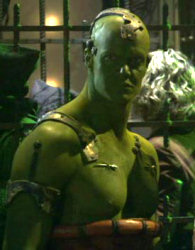
MEMBERS
Sexual dimorphic
Females - average 1.5 meters and 60 kgs.
Males - average 1.7 meters and 70 kgs, but have been observed up to 2 meters and 80 kgs.
Subspecies:
Ruddy or Orange - approximately 1-3% of the population.
Grey - listed as approximately 1-3% of the population but seem to be rare.
RESPIRATORY SYSTEM
Two lungs occupying the thoracic cavity. A diaphragm is present.
Right lung is divided into four lobes as compared to a humans three lobes.
Left lung is reduced to two lobes to accommodate the heart.
Unlike Human physiology, the lungs wrap further under the rib cage to the backbone and slightly further to the sternum providing better oxygen intake.
NERVOUS AND EXCRETORY SYSTEM
Nervous system is organized similar to Humans.
The olfactory nerve and attendant mapping to the amygdale of the brain is much more developed.
In males especially there are major connections directly between the amygdale and the nucleus accumbens.
The organization of the kidneys (two), bladder and other execratory system functions are almost identical to human counterparts.
DIGESTIVE SYSTEM
Though similar to Humans in overall organization, there is a secondary organ (referred to as a crop) that is highly vascularized and connected by a duct into the upper intestinal system.
This crop functions as a holding area to collect from the blood stream the production of simple carbohydrates that the chlorophyll in the skin produces.
It is thought that this combined with a slightly larger lung capacity, the oxygen production of the chlorophyll located in the skin to give Orions their extra endurance.
VISUAL SYSTEM
Two eyes:
Simple non compound eyes.
However, the construction is different from most other humanoid eyes in that the corneal covering does not form a lens. Instead, Orion eyes are considered to be reflector eyes in which the interior is lined with reflective material which then reflect the image to a focus. This allows attenuation of the amount of light hitting the optic nerve to be attenuated which was an adaption to the intense light of the blue white sun that was the origin of the species.
An interesting aspect of this construction is that looking into the eye through the pupil one 'sees' exactly what an Orion would perceive.
Orions are capable of perceiving light from 460nm to 850nm. Thus they cannot perceive deep blues, but can see into the near infrared range. Again an adaption to avoid the intense UV of their native system.
Due to the construction of the eye, it is the principle reason that most ocular compounds such as Retinax V do not work.
CIRCULATORY SYSTEM
Hemocyanin - copper based
The distinct colour ranging from greenish to goldish is both a product of the copper atoms being bound in heme rather than prosthetic groups and is based on replacing the magnesium of the chlorophyll found throughout the skin tissue with copper.
Hearts - four-chambered based on bilateral symmetry. However, like Terran birds the aorta bends to the right rather than to the left.
SKELETAL SYSTEM
Orion skeletal system is humanoid and little to remark on from its Human counterpart other than being somewhat denser in the males than in Human males.
The denseness of the male bones results in increased strength for the remarkable musculature that is present in many but at a reduction in the ability to provide easy replacement of blood cells.
SKIN
Orion skin is remarkable in the presence of chlorophyll. This is also an adaption to the intense UV light of their native solar system.
The subspecies mentioned above are due to the result of the non-formation of the chlorophyll and in the Ruddy Orions allowing the Anthocyanins and Carontinoids to show through. The Grey Orions show a defect in the production of all pigments.
REPRODUCTIVE SYSTEM AND REPRODUCTION
Internal insemination between males and females.
Males have bilateral testes and external phallus.
Females posses a vagina, cervix, uterus and ovaries similar to Humans.
Unlike Humans, females while undergoing menopause continue to be able to make estrogen and progesterone in normal quantities resulting in lesser effects of aging than in their Human counterparts.
The females are able to control their own fertilization through techniques that modify their considerably complex endocrine system.
The normal gestation time in Orions is approximately the same as in Humans.
ENDOCRINE SYSTEM
The endocrine system of Orions is organized similar to Humans but with some important differences.
Both male and female Orions secrete various pheromones. The most famous of which is a sex pheromone.
Though the sexual pheromone seems to be the default pheromone given off, the linkage with the amygdala and neuronal connections to the rest of the limbic system results in pheromones that can be produced based upon emotional moods.
This accounts for the noted that calmness results in-group calmness, fear in group fear and so on depending on the general mood.
It is thought that this group pheromonal production allows for the society to function better.
In Orions the pheromone release is through a special gland the Androconia gland.
In females this organ is particularly pronounced.
The attendant reception in both sexes is through the Vomeronasal organ (VNO). The VNO is the first stage of the accessory olfactory system, and contains sensory neurons that detect chemical stimuli. The axons from these neurons project to the accessory olfactory bulb, which targets the amygdala and bed nucleus of the stria terminalis, which in turn project to the hypothalamus.
The males this organ is enlarged and has an abundance of neuronal ties. It is thought this is the reason that Orion males can become easily enraged and aggressive when exposed to Orion female pheromones.
Constant exposure induces a dependency on a particular pheromone trait and it is thought that this is why it has been said that the females enslave the males.
METABOLISM
Endothermic.
Body temperatures tend to differ from Human in being 10 degrees warmer when active and 10 degrees cooler when inactive.
Due to their rather lean nature compared to other endothermic humanoid females, female Orions tend to have several short sleep cycles rather than one long one.
OTHER
There was thought to be a subcaste of the Orion race that possessed animalistic qualities, giving rise to the legend of the "Orion animal woman". They were claimed to be less intelligent and behaved in a semi-animalistic fashion. It is unknown if these traits indicated a subspecies or a genetic alteration or were simply a myth based on their legendary sexual appetites, violence and savage Orion behavior. It may have derived simply from a lack of educational opportunities.
6.7 Tholian
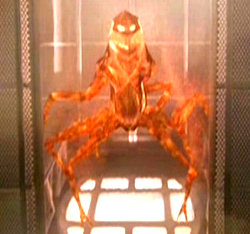
MEMBERS
Sexual monomorphic - hermaphrodites.
Individuals range from – 1.56 meters and 83 kg to 1.73 meters and 100 kgs.
On average approximately same height but heavier than Humans.
RESPIRATORY SYSTEM
A series of spiracles in the exoskeleton.
NERVOUS AND EXCRETORY SYSTEM
The basic Tholian nervous system plan consists of a series of body segments, each equipped with a pair of connected ganglia, with a paired nerve cord connecting adjacent ganglia in each segment.
The ganglia are bulbous structures consisting of neuron cell-bodies and supporting or glial cells and acts as a local processor or computer. Each ganglia are interconnected by neurons, constituting a computer network. The ganglia of the head segment form a fused mass corresponding to the head area and thus can be considered more or less the brain.
Tholians radiate unused heat and UV light through their carapace but also through specialized organs.
These organs can be used defensively and offensively to concentrate a ‘blast’ of radiation.
DIGESTIVE SYSTEM
Tholians do not have a digestive system. They absorb heat and other forms of radiation primarily ultraviolet (UV) directly through the carapace.
VISUAL SYSTEM
Two eyes:
The ‘eyes’ are actually more akin in function to the pit organ of various other organisms.
The eyes detect changes in the thermal radiation of the surroundings.
CIRCULATORY SYSTEM
Tholians are based off a completely different biochemistry. Instead of water, the basic solvent of the species is sulfuric acid. It has a very wide liquidity range (10 to 338°C). Though functions of metabolism would be best in the high temperatures. This reflects in the fact that Tholians environments are invariably hot but the creatures can function for a period of time in much lower temperatures.
H2SO4 works as acid and HSO4- as base.
The C = C double bond is used to store energy.
Due to absorbing radiation the need for a circulatory system is vastly reduced. Tholians thus use an open system in which the internal tissues are bathed in fluid that is moved by the movement of the organism supplemented with small pumping chambers in the various sections.
SKELETAL SYSTEM
Tholians use a silica based carapace exoskeleton.
There is a ‘head’ that contains the eyes and other sensing and communicating organs.
A main body from which two jointed arms extend ending in two jointed fingers.
The lower body is supported by six jointed legs also ending in two split toes arranged radially around the body allowing for quick movement in any direction.
SKIN
None. External silicon based carapace.
REPRODUCTIVE SYSTEM AND REPRODUCTION
Little is known.
Tholians are hermaphroditic.
ENDOCRINE SYSTEM
Little is known.
METABOLISM
Endothermic.
Approximate body temperature 207 C.
Radation absorbed is transformed using a reverse Krebbs cycle.
OTHER
Tholians due to their generalized anatomy are extremely difficult to kill. The lack of centralized heart, respiratory system and neuronal organization makes the creature able to function even with massive amounts of damage.
6.8 Tribble
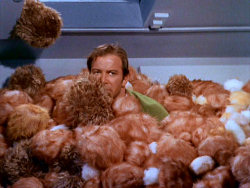
MEMBERS
Single morphic and hermaphroditic.
RESPIRATORY SYSTEM
A single lung with opening at a spiraculum located on the dorsal side.
No diaphragm, respiration is by muscular contraction and the attendant coo is due to air moving in and out of the spraculum.
What is note-worthy is that the harmonics of the 'coo' can elicit various states of euphoria in several sentient species. While not known perhaps due to the rather slow nature of movement in this species, it may have evolved as a protective mechanism. This is entirely speculative as the Klingons destroyed the native habitat long ago.
NERVOUS AND EXCRETORY SYSTEM
Nervous system is simple. The brain is located on the ventral side orientated toward the anterior.
Tribbles are non-sentient.
A single functioning kidney is present.
DIGESTIVE SYSTEM
The stomach and intestines lie in the ventral area and surprisingly for such a noted eating machine, are rather reduced. Though Tribbles have voracious appetites their diet is actually quite limited in what their systems can handle.
VISUAL SYSTEM
No visual system is present. However, Tribbles do posses a parietal eye that is photosensitive.
This similar to other creatures possessing such a structure and is connected to the epithalamus and probably regulates a circadian rhythm.
CIRCULATORY SYSTEM
Tribbles posses an open circulatory system.
The entire body acts as the hemocoel in which the organs are bathed in the hemolymph.
The hemolymph is composed primarily of water, dissolved salts, proteins and lipids.
Hemocytes are present which act as a rudimentary equivalent to immune cells in more specialized creatures.
Hamocyanin-based, the blood is normally colourless like that of Terran insects.
The heart is a simple two-chambered affair consisting of one ventricle and one atrium.
SKELETAL SYSTEM
None.
Fluid pressure and musculature account for the general shape of a Tribble.
REPRODUCTIVE SYSTEM AND REPRODUCTION
Perhaps the best-known function about Tribbles is their prodigious capacity to reproduce. The uterus occupying a major part of the body in which embryos are brought to term.
There has been no recorded instance of a male Tribble.
Tribbles are Agameogenetic (no male gamete required).
In order for Tribbles to continue their line without becoming inbred, a form of the Meseleson effect is employed.
In Meseleson asexual reproduction, the alleles in various cells began to evolve independently and over time produce differing genomes within the same animal.
ENDOCRINE SYSTEM
The endocrine system of Tribbles is very complex. They use various scents and odors to determine the presence of predators, food and each other.
The scent system seems to be why Tribbles react to Klingons the way they do as it is thought the Klingon scent elicits a fear response.
METABOLISM
Endothermic.
Body temperatures tend to be slightly above most humanoid creatures and along with the soft fur give that warm cuddly feel many humanoids attribute to them.
6.9 Trill (Host)
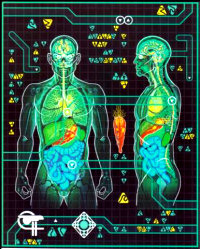
MEMBERS
Sexual dimorphic.
Females - average 1.65 meters and 62 kgs.
Males - average 1.8 meters and 72 kgs.
On average males and females tend to be slightly taller and slightly slimmer than Humans.
RESPIRATORY SYSTEM
Two lungs occupying the thoracic cavity. A diaphragm is present.
For all purposes the respiratory system can be considered equivalent to Humans.
NERVOUS AND EXCRETORY SYSTEM
Nervous systems is organized similar to Humans with significant differences:
The basal ganglia sometimes referred erroneously as the cerebral ganglia is duplicated in Trills.
One set of major neurons goes to the pouch (see reproduction) and it is through these neurons that the symbiont makes it connections.
If there is no symbiont (unjoined), the secondary ganglion becomes quiescent.
If joined, the prime neurotransmitter to help co-ordinate the two ganglia is isoboramine.
In addition there are many connections from the skin receptors located in the distinctive spots or markings that impinge directly the nucleus accumbens.
This connection results in sexual arousal by touching or stroking of the markings in Trills.
The hypothalamus is the primary organ producing isoboramine.
The organization of the kidneys (two), bladder and other execratory system functions are almost identical to Human counterparts.
DIGESTIVE SYSTEM
Organization of the digestive system is almost identical to Humans except for the noted absence of an appendix.
VISUAL SYSTEM
Two eyes:
Simple non compound eyes.
Virtually identical to Humans but the pigmentation tends to be different and generally darker.
CIRCULATORY SYSTEM
Hemoglobin - iron based.
Hearts - four chambered based on bilateral symmetry. For all purposes of treatment not different from Humans.
SKELETAL SYSTEM
Trill skeletal system is humanoid and little remarks on its Human counterpart other than being somewhat more gracile than in Humans.
SKIN
Trill skin and pores are similar to Humans' but with the addition of distinctive patterns called 'spots' that start at the forehead, run down the side of the neck, over the clavicles and then turn near just under the nipple area toward the anterior then move down the sides just under the scapula near the latissimus dorsi under the arm, then pattern away just above the iliac creast to continue down the side of the hip, the thighs then to the ankles.
The spots are distinctive between each individual. The spots are thought to have served as a sexual attractant. As mentioned above, the areas of the spots are enriched with nerves that when touched or the skin is stroked in the area, impinge directly on the nucleus accumbens which involves sexual arousal.
REPRODUCTIVE SYSTEM AND REPRODUCTION
Internal insemination between males and females.
Males have bilateral testes and external phallus.
Females posses a vagina, cervix, uterus and ovaries similar to Humans.
Unlike humans though, Trills are marsupials. It is the pouch that is used for the symbiont as well as rearing of young.
Females are able to control their own fertilization through techniques that modify their considerably complex endocrine system.
The normal gestation time in Trills is approximately the same as in Humans.
ENDOCRINE SYSTEM
The endocrine system of Trills is organized similar to Humans.
However, in many Trills the endocrine system cannot stimulate enough production of isoboramine and thus cannot support the necessary neurotransmitter to support a symbiont.
The hypothalamus in Trills is especially sensitive to sudden surges of hormones and can easily become damaged enough that it ceases or cannot support isoboramine production.
METABOLISM
Endothermic.
Body temperatures tend to be nearly identical to Humans.
OTHER
No discussion of the Trill anatomy is finished without comment on the symbiont. These are intelligent vermiform organisms that are remarkably long-lived, and with joining, can bring the memories of previous hosts along the connection.
This seems to be a case of mutual symbioses in that the symbionts can travel much further than their normal environment and the Trill host gains many memories and skills.
Trills themselves attribute the remarkable rise of their civilization to the skills they gained from the symbionts.
6.10 Vaeron

MEMBERS
Two biological genders; male and female.
Known Vaeron males range in height and weight between 5’11” – 6’ 2” and 165 lbs – 200 lbs.
Known Vaeron females range in height and weight between 5’11” – 6’ 2” and 145 lbs – 155 lbs.
Sexuality appears to be pansexual across the entire species, although the natural breeding process can only occur between a male and female.
LIFE SPAN
Vaeron lifespans vary greatly depending on the Talent they develop and their lifestyle.
On average, as far as mathematical statistics go, Vaerons live around 600 years, however many live much longer, and many others don’t live that long.
The speed of ageing can also vary depending on the Talent developed, but all Vaerons age much slower than humans.
The only speed of ageing that is the same for all Vaerons is during the younger years before adulthood, after which the ageing process slows down; their ageing slows down even more at around the age of 250.
Between birth and the age of 70, a Vaeron is considered a ‘minor’ and legally still the full responsibility of their parents; during this time they are the physical and mental equivalent of a Human child, then developing into the equivalent of a Human teenager.
Despite their extended lifespans, they are susceptible to injury and disease just as other humanoids are.
ORGANS AND SKELETON
They have two hearts even though only one is required for survival. This led to a belief that they have two souls rather than just one.
Skeleton and muscle mass appears to be similar to Humans.
Known males tend to be naturally broad across the shoulders and chest in adulthood, and known females are the same average height as males, rather than commonly shorter.
ATTRIBUTES AND INTOLERANCES
Vaerons are much more sensitive to hot and cold.
They have fast reflexes and hand/eye co-ordination.
They also have a good sense of hearing and sight, but the other senses are on par with Humans.
Many Vaerons are more susceptible to fevers and illness compared to a lot of other species.
SLEEP
Vaerons require sleep every three days rather than every day.
However, as a result, they require more food and drink.
Some Talents that result in the expenditure of a lot of energy will then require a large amount of sleep to recover.
DIET
Vaerons are able to share a similar diet to Humans.
They require more food and drink in comparison to Humans.
TALENTS
Vaerons develop different mental and physical abilities when they reach adulthood. These abilities are called the 'Talent'. The people saw them as gifts from the gods.
These Talents vary from person to person but tend to be inherited through a bloodline.
Examples of known Talents include transferers, telepaths, empaths, telekinetics, bloodtellers, machine whisperers, energisers and psi-duelists.
Vaerons are highly reluctant to share details about their Talents, or explore them with non-Vaerons. As such, there have been no known medical investigations by non-Vaerons.
Categories: Science Manual

